Trends come and go, but content marketing is here to stay. Even today, it remains a reliable strategy if you want to improve brand awareness, promote user education and establish authority within your industry. However, content marketing has changed considerably over the years! For example, content marketing trends of 2020 may not be as effective today.
With user behavior, tastes and expectations evolving, it is imperative that you stay up-to-date on trends to retain relevance. Ultimately, this means learning about this year’s content marketing trends and applying them to your strategies. So, let’s dive deep into content marketing and take a look at the latest developments.
1. Generative AI Becomes a Co-Creator, Not a Replacement — The Biggest Content Marketing Innovation So Far
Artificial intelligence has helped speed up the writing process because, with just a single prompt, it can create a full article. However, even though AI is one of the biggest content marketing trends right now, human strategy still matters. In fact, it matters now more than ever.
Writers and strategists must guide prompts and add their own voices to differentiate themselves from generic AI content. Content marketing trends are moving towards using AI as an assistant, allowing you to:
- Create drafts;
- Develop an article outline;
- Repurpose existing content;
- Add personalization.
However, if you choose to generate all your content with AI from scratch, be prepared for the consequences. AI can fabricate facts and hallucinate sources. Not to mention the generic tone that can make your text dull and forgettable for readers.
Moreover, beware of SEO saturation. The last thing you want is to create too much new content for popular keywords and yield little to no impact due to the extreme competition.
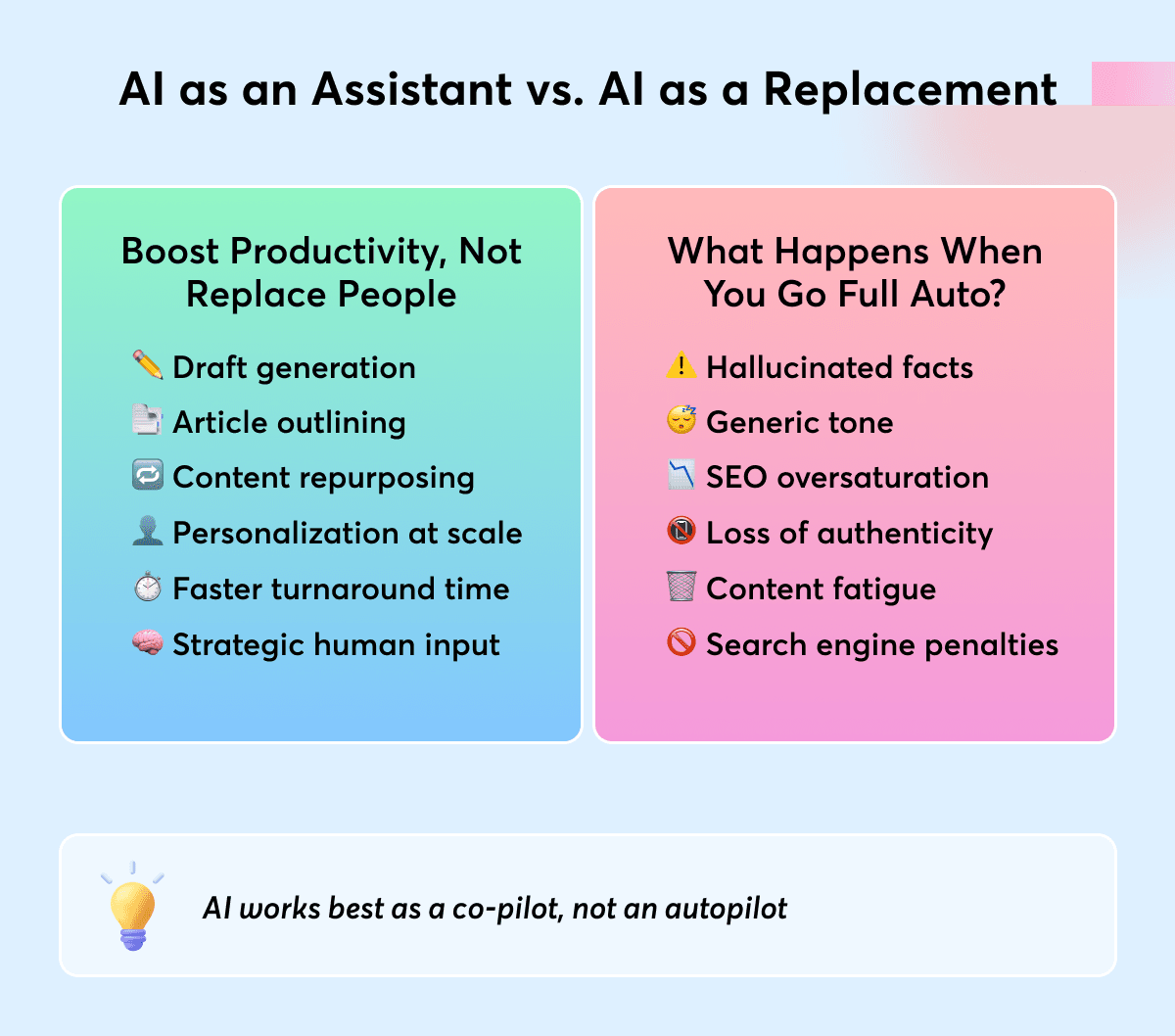
2. The Future of Content Marketing Search is Changing From Keywords to Conversations
Remember how SEO was the most important element of organic search? Updates to search engine algorithms heavily influenced content marketing trends in the past, but they’re not the only things that matter now. The rise of AI-powered search engines like Perplexity, ChatGPT and Gemini are reshaping the way users find information.
From looking at blue links and picking the ones you think may have the answer that you’re looking for, content marketing trends are moving toward zero-click content and embedded answers. GEO (Generative Engine Optimization) is becoming a critical layer. Pursuing ranking alone won’t do the trick with the latest content marketing trends. To maintain relevance in organic search, it’s important to optimize for intent and information clarity.
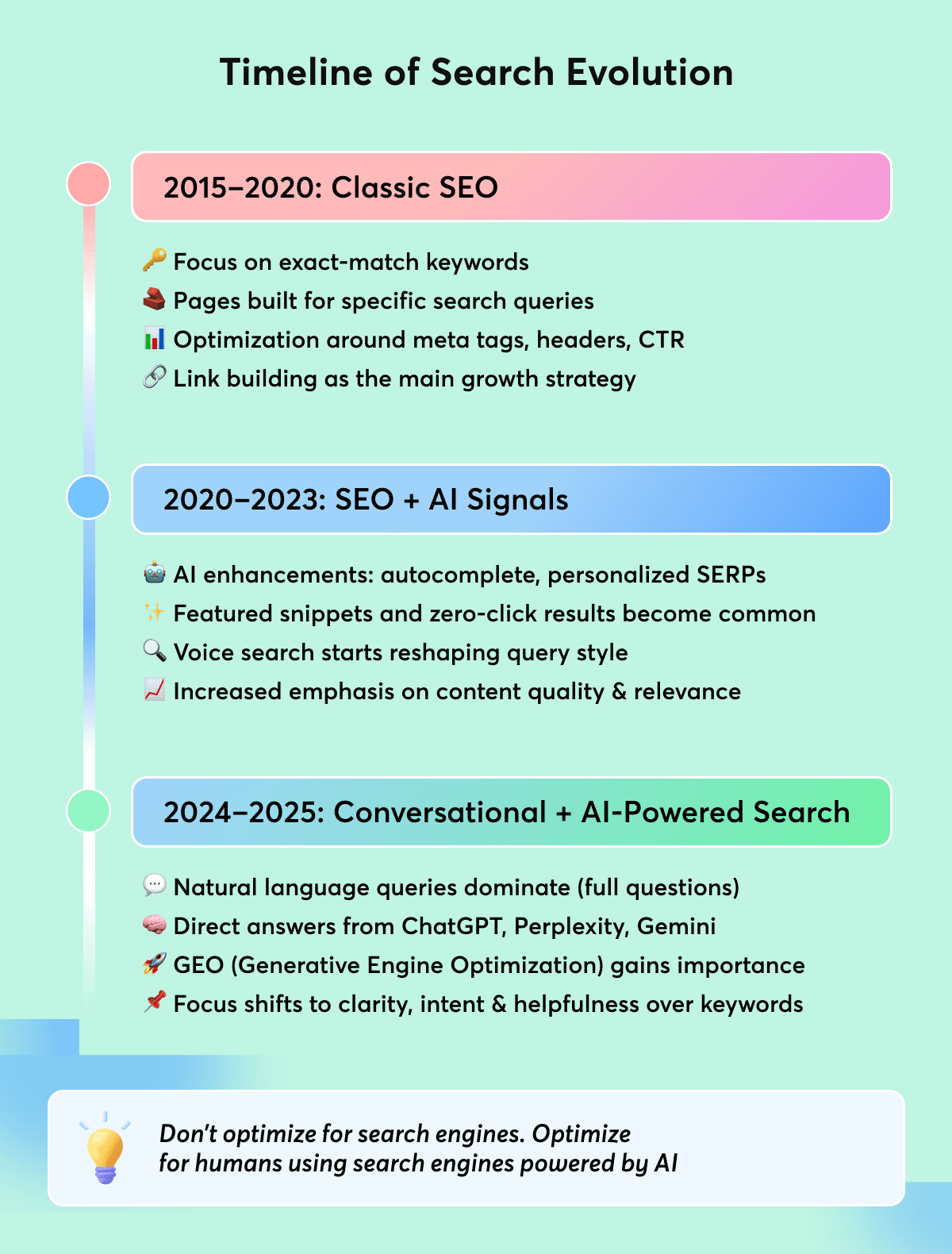
3. First-Party Data and Content Personalization Convergence as a Content Marketing Trend
Third-party cookies have long been reliable in tracking users across the web. However, with regulations around data collection becoming stricter, you may need to rethink how you collect information. Content marketing trends are moving towards privacy-friendly cookieless tracking that uses first-party data.
With this development, behavior segmentation is employed more often. So, instead of generic content, you can build hubs and custom journeys based on user behavior.
Content marketing is moving away from one-size-fits-all solutions and instead tailoring content based on user type, industry and even lifecycle stage. Using both customer data platforms (CDPs) and AI, you’ll be able to do this at scale. This will ensure you deliver the right message and format when most relevant.
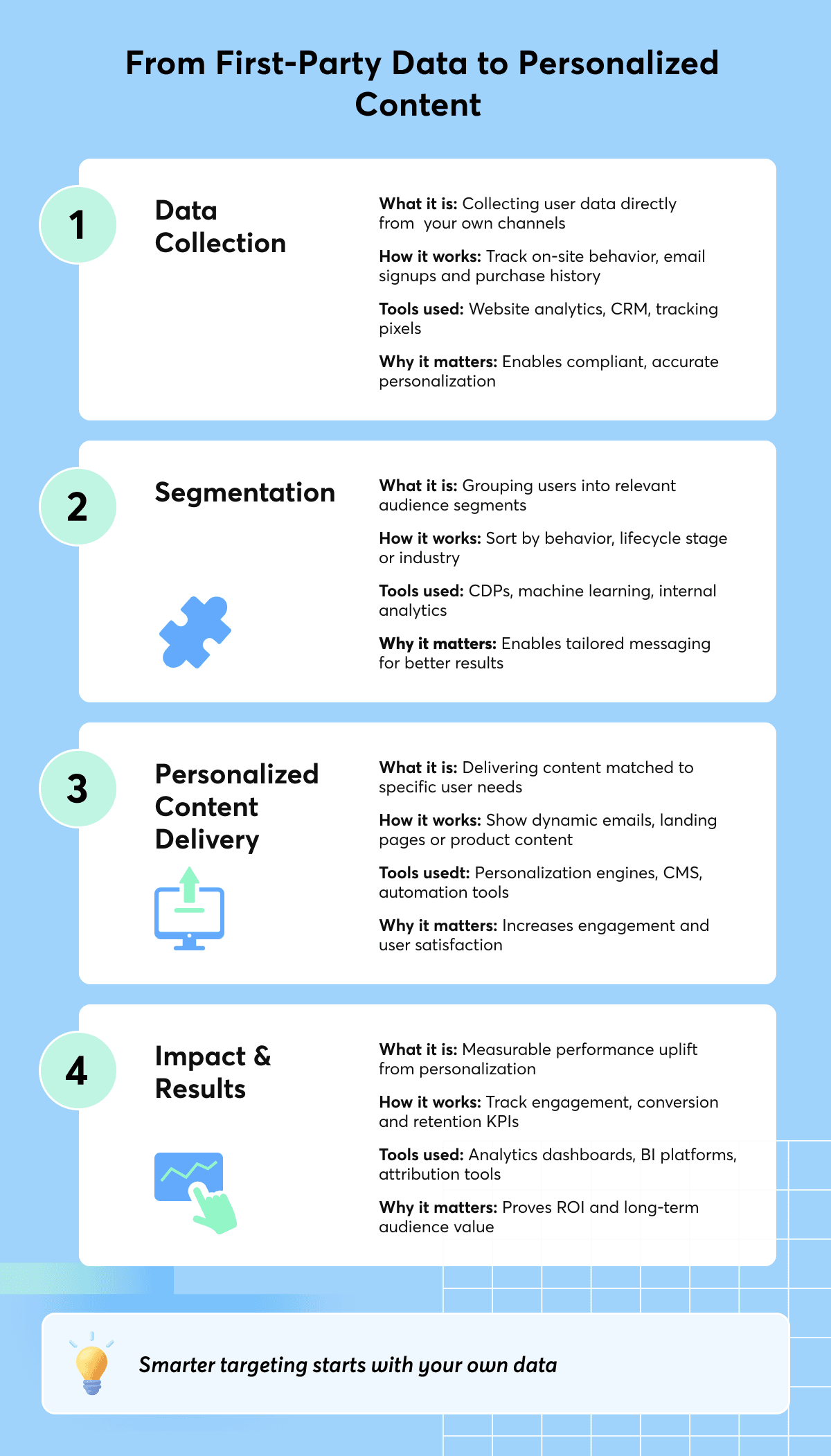
4. Visual Content Marketing Trends Move from Static to Interactive
The shift to interactivity isn’t just with visual content. With so much new material being produced, even as you read this, marketing trends have gravitated toward interactive content. More marketers are now using the following to get the attention of their target market:
- Quizzes
- Calculators
- Story ads
- Lookbooks
- Shoppable articles
- Video shopping
- Integrated CTAs
As interactive and shoppable content marketing trends, we see higher engagement and conversion rates, especially on mobile. Today, there are also specialized tools that you can use to create interactive content. A few favorites include MGID Story Ads, Figma Embeds, Outgrow and Smartly.io.
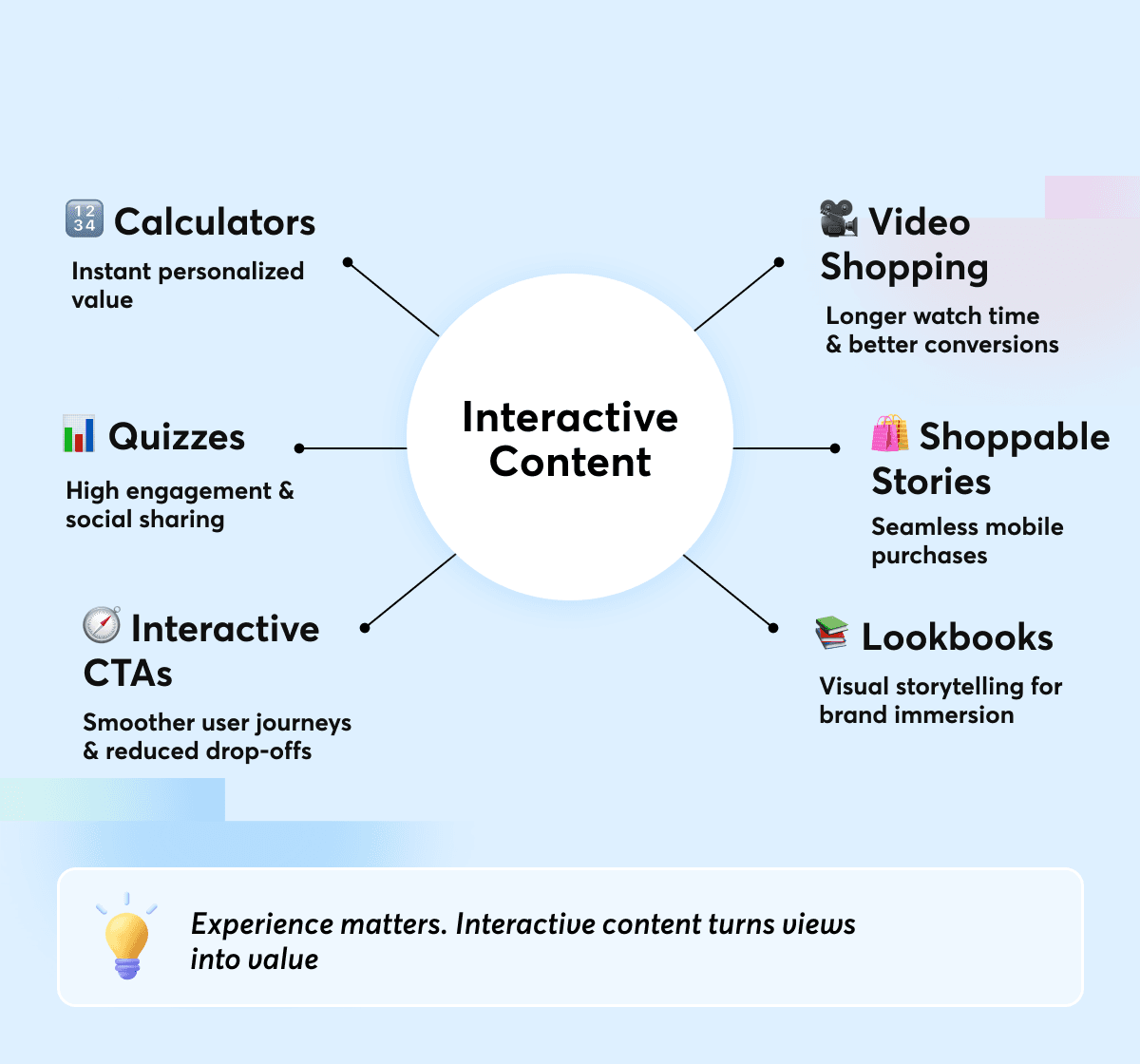
5. SEO and Content Marketing Trends Gravitate Towards Human-Centric Storytelling
The use of AI content has created an unintended consequence. With users tired of seeing the same thing over and over, content marketing trends value authentic human voices even more. Here’s what we’ve noticed:
- Brand narratives, customer stories, employee content and behind-the-scenes content are more sought after.
- Empathy, vulnerability and “realness” are becoming a trust factor.
- Video, podcasting and UGC are now common formats for building emotional connections.
Content marketing trends simply emphasize what a brand’s relationship with its audience should have always been about: real connections. Brands that want to stand out need to do more than provide information.
6. The Balance of Content Velocity and Quality Remains a Strong Content Marketing Trend
Marketers feel pressured to maintain a frequent publishing schedule to keep their brand at the top of users’ minds. However, search engines are moving away from rewarding publishing just for the sake of it. There should be real value in every post — and not the low-value AI drivel that some brands try to push to their audience.
There may be new content marketing trends next year, but we promise you that doing these things will always be useful:
- Regularly refreshing your evergreen content;
- Pursuing thought leadership and deep dives over low-quality AI posts;
- Balancing output speed with brand voice and usefulness.
Essentially, aim for quality over quantity; nonetheless, don’t publish so infrequently that your audience forgets about the brand.
7. Video-First Strategies Dominate New Marketing Trends
Videos are highly engaging forms of content. That’s why many marketers use them to capture the attention of their audience. Right now, content marketing trends towards the following:
- Short-form videos like reels, shorts and TikToks at the top of the funnel that can potentially go viral and increase brand reach;
- Long-form videos like explainers, documentaries and series that can help with brand building;
- SEO for video that include transcripts, schema and closed captions that make content searchable online.
We’re also seeing the rise of AI-edited video and auto-captioning tools, allowing brands and marketers to quickly generate content with minimal effort.
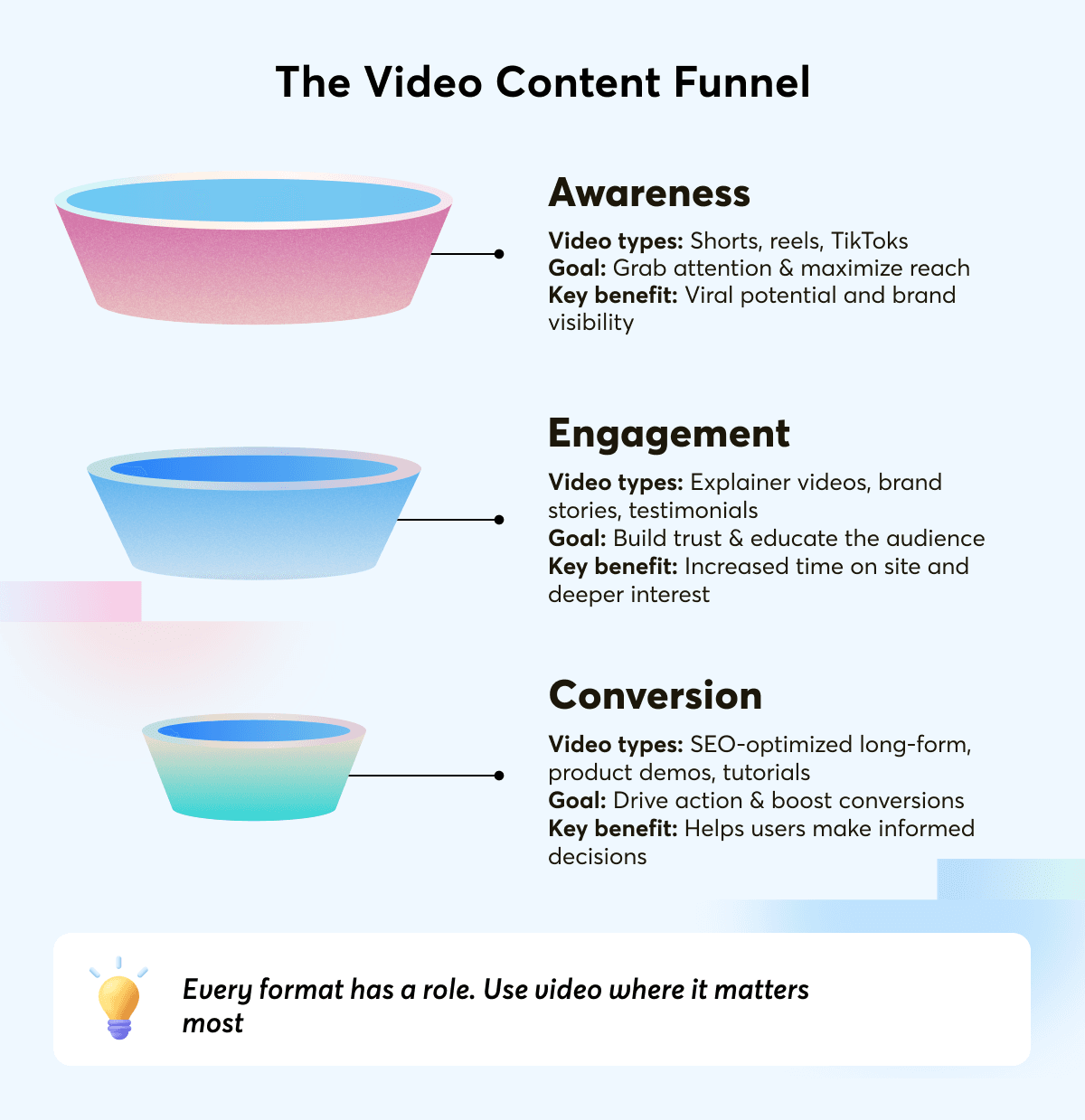
8. Community-Driven Content Marketing is the Future
Today, your audience isn’t just, you know, your audience. The shift from pure broadcast to community co-creation means that your audience are active participants in building your content. To fulfill this desire to be more involved, you can:
- Engage with brand ambassadors, power users and creators as content contributors;
- Explore Reddit-style engagement and Discord groups;
- Collaborate with other firms to form co-branded campaigns.
User-generated content promotes content performance and nurtures customer loyalty. With content marketing trends favoring community-driven initiatives, consider compatible content formats like AMAs, co-authored posts and idea contests.
9. Native Advertising and Sponsored Content Get Smarter, Making the Latest Brand Marketing Trends More Powerful
These days, native ads are practically wearing camouflage because of how well they blend with the publisher’s site. With smarter targeting and cleaner formats, users are becoming more receptive to your messaging.
We recognized the value of native advertising well before it became a major trend in content marketing. Editorial-style ads that fit within the context of the user’s browsing experience perform better.
Platforms like MGID have allowed performance and storytelling to coexist. In that sense, consider us the Swiss knife of content marketing trends. By using native to distribute high-value or shoppable content (not just banners!), you can generate sales while strengthening your brand.
10. Trends in Content Marketing Roles Move from Content to Performance Teams
Siloed roles are disappearing quicker than free snacks at a meeting. Content marketing trends favor talent with an understanding of funnels, CRO and paid distribution. Be prepared to develop skills in data storytelling, automation and multichannel strategy! However, even with multi-talented individuals on the team, collaboration remains extremely valuable.
Today, you can witness content marketing trends expanding. The movement from content to performance teams means you should expect to work with other departments that may have the same goals. With the KPI shift from just traffic to revenue, engagement and customer lifetime value, there needs to be more hands on deck.
Bonus Content Marketing Trend: The Rise of Content OS & Workflow Automation
Do you remember what creating content was like just a couple of years ago? You had to use a generic platform to manage the work involved in campaigns. Content marketing trends of 2022 began the shift towards efficiency, moving towards collaboration and integrations to improve output.
Later on, content marketing began incorporating artificial intelligence. Today, it’s a huge part not only of the creation process but also of campaign management. Learn about how all these content marketing trends have contributed to content marketing’s centralization and automation.
The Use of Centralized Platforms for Everything from Planning to Distribution
Although not as big a hit as AI, one of the most influential content marketing trends today is the introduction of centralized platforms. With this, those who are involved in the campaigns can do the following:
- Plan: This is one of the older content marketing trends, but it’s been proven to be more than a fad. Using a centralized dashboard, users can assign roles, view the content calendar and more.
- Create: This allows writers to collaborate within the same platform.
- Approve: It routes drafts to the correct authority right away, which speeds up the publishing process.
- Distribute: Popular content marketing platforms let you publish directly to blog pages through integrations.
With these measures, you save time while still generating the best content from existing talents.
Using Integrations to Expand a Platform’s Capabilities
As mentioned, content marketing is moving toward centralization. So, it’s no surprise that integrations are as popular as they are right now. Here are the ones that have become even more widespread thanks to content marketing trends.
- Notion: For building a knowledge base, which is useful for ensuring consistency across everything published
- Airtable: For managing content pipelines, assets and deadlines in one place
- Contently: For scaling your content creation process with workflows, tools and outside talent
- Writer: For real-time checking of grammar, tone and style across all works produced
- Jasper: For generating AI content that can be used for social media, blogs and more
- MGID: For distributing content across publisher platforms
If content marketing trends continue in the same direction, expect more integrations soon.

Incorporating Artificial Intelligence and Automation into Existing Processes
Gone are the days when humans were completely in charge of creating content and making sure that the flow from planning to publishing went smoothly. One of the biggest content marketing trends is artificial intelligence, and you’ll see a lot of it, even outside this industry.
Along with automation, it does two things that make us confident these content marketing trends are here to stay:
- Saves time by reducing how long it takes to produce content;
- Improves governance by providing real-time analytics and strategy recalibration.
With these content marketing trends, you’re free to focus on higher-level strategy formulation and implementation. Artificial intelligence and automation can take care of the rest.
Modifying Success Metrics Based on the Newest Content Market Trends
There’s no doubt that the shift towards artificial intelligence has facilitated more personalized content. So, just like how certain 2022 content marketing trends are still relevant today, we expect more of the same for a lot of items on our list.
This means that we need a way to measure success. Considering the latest content marketing news, sticking to simple metrics like page views and bounce rate isn’t enough. Here are a few numbers to keep an eye on.
Track True Interactions within the Page
Instead of following the number of sessions or clicks, look at the deeper interactions that you can measure when someone visits the page. You’ll be able to maximize the gains from content marketing trends when you also track the following metrics.
- Attention time – How long the user paid attention to the content
- Scroll depth – How far the user scrolled to read
- Clicks on interactive elements – Which elements or functions captured their attention
With AI being one of the biggest content marketing trends to date, these metrics will allow you to gain meaningful insights into the impact of existing published works.

Measure What Drives Action — Not Just What Gets Views
We’re not saying that you should stop monitoring views altogether. However, you should always evaluate the ability of each piece to drive action. Here are a few metrics that may be relevant for you:
- Clickthrough rates;
- Affiliate conversions;
- Form submissions.
As discussed, content marketing trends towards interactivity. So, engagement will always be important, no matter what part of the funnel the content piece is supposed to serve.
Use Smarter Attribution Models for Multi-Channel Journeys
Way before the 2023 content marketing trends, we observed the way users interacted across different platforms before making a decision. Consequently, simply looking at the last click the user made may not give you the full picture of what they decided to buy.
Content marketing trends have brought about modern attribution models, such as multi-touch and data-driven metrics, to credit every asset that contributed to the conversion. You’re likely using multiple channels to publish, so this will be very important, too!
Factor Audience Quality, Not Just Quantity
Since we’re going beyond page views, why not check who’s visiting the site as well? Content marketing trends emphasize both quantity and quality of content, and we think this should extend to evaluating visitors to your site.
For example, if you’re running a website about video games, a million visitors of 65+ retirees is probably bad news. We’re sure there’s a grandpa somewhere that’s pulverizing seasoned players on Dota 2, but let’s face it, most of them are playing bingo or asleep by 7 pm.
So, what do you need to do? Evaluate the conversion rates and lifetime value based on the content that they interact with. This way, you’ll know which content is resonating with them.
Breaking Points: What Could Derail Your Incorporation of Content Marketing Trends in 2025 and Beyond?
Just as there are innovative techniques for measuring metrics, there are also new ways to fail. For instance, companies and brands have encountered issues with artificial intelligence in which tools that are supposed to help end up bogging down the process.
Content marketing trends also rarely consider the developments in data privacy laws. This can make strategies less effective. Finally, since content marketing trends are designed to work over time, it can be hard to justify their use. With no immediate ROI, decision-makers may decide to rechannel their resources elsewhere.
AI Overload and Content Fatigue
As we’ve continuously discussed here, AI is a huge driver for many content marketing trends. It’s done a lot to make stellar outcomes easier to achieve since it’s like having extra team members available on demand. However, its overuse in content marketing trends may come with a hefty price tag.
With everyone using the same AI models to create content, your messaging may end up sounding generic. So, instead of content marketing trends giving you the tools to stand out, your brand may end up failing to make an impact.
Data Privacy Restrictions Limiting Targeting
Content marketing trends are all about getting richer insights to create more personalized messaging. However, there’s one major problem here. All content marketing trends are a response to current market conditions and demands. For example, with developments in data privacy restrictions happening all the time, it’s possible that some solutions won’t work anymore.
You may find yourself with limited targeting options, which can affect the effectiveness of your content. If you can’t incorporate the current content marketing trends into data privacy-friendly strategies, you may not fully reach your intended users.
Tool Sprawl Slowing Teams Down
Tools are supposed to help those who create content, allowing them to keep up with the demand for more frequent publishing. In fact, we’re seeing trends toward the incorporation of tools into content marketing processes. On paper, there’s no way that this can go wrong, but consider that these tools may not be created by the same developers.
When we looked at what the content marketing trends are for 2025, we noticed a surge in the use of tools. However, many teams are failing to include them in their systems. The result? They must use them individually, which slows down teams instead of speeding them up.
Difficulty Proving ROI in Long Cycles
Many decision makers are asking, what is marketing new trends and ideas in the industry good for if it’s not going to generate income? This is common, especially with those working with tighter budgets. After all, the demands that content marketing trends impose on companies and brands can eat up funds.
However, most types of content are used at the bottom or middle of the funnel. Content marketing trends can help create a bigger pool of prospective clients later on, but since they’re not directly responsible for the sale, they tend to be undervalued.
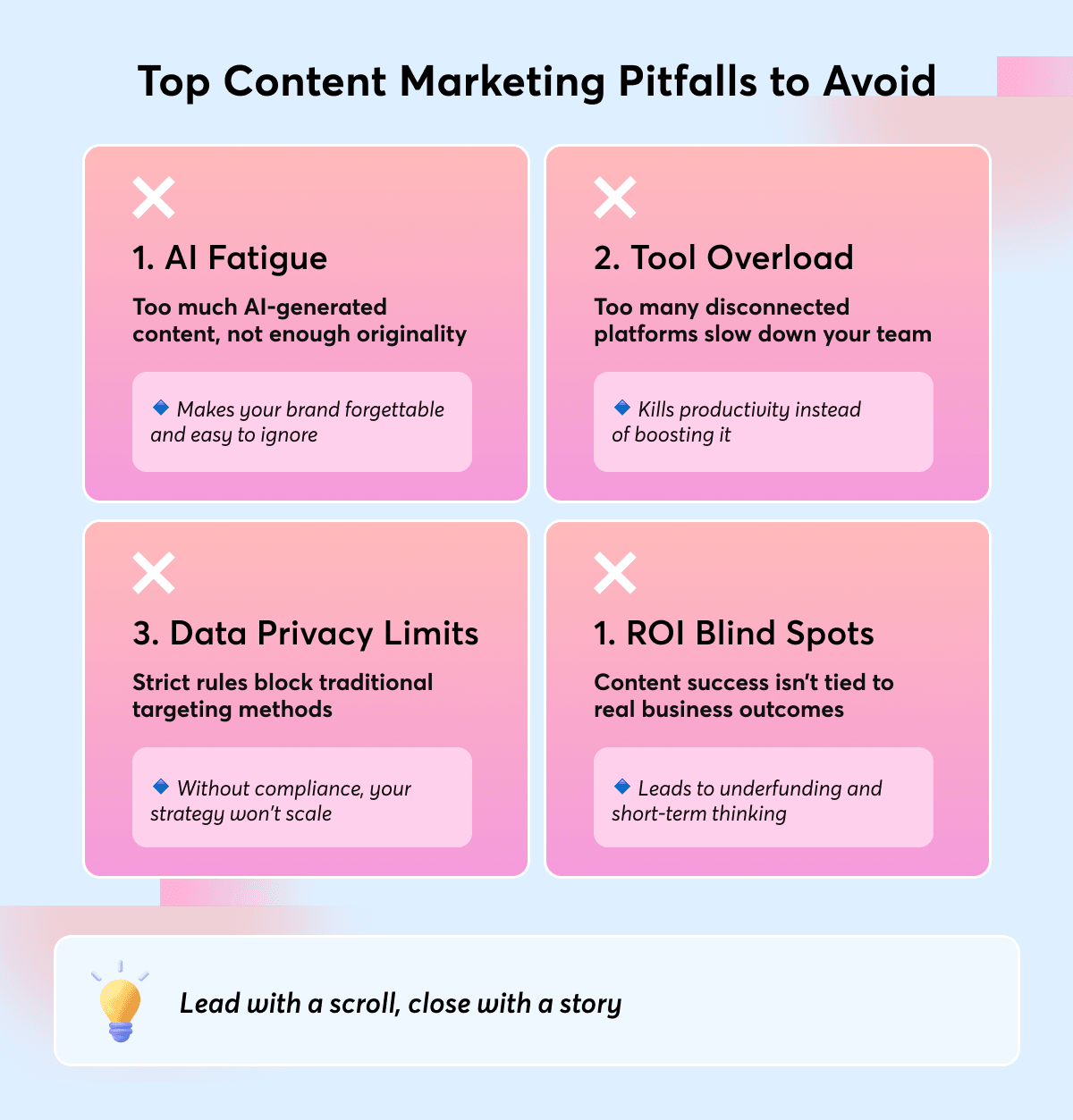
Does Content Marketing Still Work? Yes, But…
Marketing in 2025 demands a smarter, more adaptive content strategy. Blend AI with human creativity, scale with personalization and focus on performance. Content marketing trends demand efficiency and the human touch as the competition becomes even tougher and users become disillusioned with AI content.
We’ve seen how the content creation trends of 2024 are being replaced with those of 2025. Nothing is permanent at this point, so we encourage experimentation and cross-functional collaboration. Discover new ways to get ahead of content marketing trends and continue to make an impact on your audience.
Finally, explore MGID as a distribution partner for native and content-based campaigns. With the speed at which content marketing trends are changing, diversification will always be rewarded.





